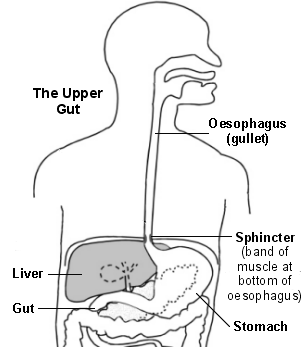What is the oesophagus?
The oesophagus (gullet) is part of the gastrointestinal tract (the gut). When we eat, food passes down the oesophagus into the stomach. The upper section of oesophagus lies behind the windpipe (trachea). The lower section lies between the heart and the spine.
There are layers of muscle in the wall of the oesophagus. These contract to propel food down into the stomach.
There is a thickened circular band of muscle (a 'sphincter') at the junction between the oesophagus and stomach. This relaxes to allow food down, but normally tightens up and stops food and acid leaking back up (refluxing) into the oesophagus. In effect the sphincter acts like a valve.

What is cancer?
Cancer is a disease of the cells in the body. The body is made up from millions of tiny cells. There are many different types of cell in the body, and there are many different types of cancer which arise from different types of cell. What all types of cancer have in common is that the cancer cells are abnormal and multiply 'out of control'.
A malignant tumour is a 'lump' or 'growth' of tissue made up from cancer cells which continue to multiply. As they grow, malignant tumours invade into nearby tissues and organs which can cause damage.
Malignant tumours may also spread to other parts of the body. This happens if some cells break off from the first (primary) tumour and are carried in the bloodstream or lymph channels to other parts of the body. These small groups of cells may then multiply to form 'secondary' tumours (metastases) in one or more parts of the body. These secondary tumours may then grow, invade and damage nearby tissues, and spread again.
Some cancers are more serious than others, some are more easily treated than others (particularly if diagnosed at an early stage), some have a better outlook (prognosis) than others.
So, cancer is not just one condition. In each case it is important to know exactly what type of cancer has developed, how large it has become, and whether it has spread. This will enable you to get reliable information on treatment options and outlook. See separate leaflet called 'What are Cancer and Tumours' for further details about cancer in general.
What is cancer of the oesophagus?
Cancer of the oesophagus is sometimes called oesophageal cancer. It is uncommon in the UK. However, in the last 20 years or so the number of cases diagnosed each year has risen. There are two main types:
The symptoms, treatment and outlook are similar for both of the these types. (There are some rare types of cancer which arise from other cells in the oesophagus. These are not dealt with further in this leaflet.)
What causes cancer of the oesophagus?
A cancerous tumour starts from one abnormal cell. The exact reason why a cell becomes cancerous is unclear. It is thought that something damages or alters certain genes in the cell. This makes the cell abnormal and multiply 'out of control'. (See separate leaflet called 'What Causes Cancer' for more details.)
Many people develop cancer of the oesophagus for no apparent reason. However, certain 'risk factors' increase the chance that cancer of the oesophagus may develop. These include:
What are the symptoms of cancer of the oesophagus?
When a cancer of the oesophagus first develops and is small it usually causes no symptoms. Some do not cause symptoms until they are quite advanced. As the cancer grows the initial symptoms which may develop usually include one or more of the following.
If the cancer spreads to other parts of the body, various other symptoms can develop.
All the above symptoms can be due to other conditions, so tests are needed to confirm cancer of the oesophagus.
How is cancer of the oesophagus diagnosed and assessed?
Initial assessment and gastroscopy
If a doctor suspects that you may have cancer of the oesophagus, he or she will examine you to look for signs such as a lump in your abdomen, etc. The examination is often normal, especially if the cancer is at an early stage. Therefore, a gastroscopy (endoscopy) is usually arranged.
A gastroscope (endoscope) is a thin, flexible, telescope. It is passed through the mouth, into the oesophagus and down towards the stomach. The endoscope contains fibre optic channels which allows light to shine down so the doctor can see inside. See separate leaflet for details about gastroscopy.医.学 全在.线,提供www.med126.com
Biopsy - to confirm the diagnosis
A biopsy is when a small sample of tissue is removed from a part of the body. The sample is then examined under the microscope to look for abnormal cells. When you have a gastroscopy, if anything abnormal is seen then the doctor or nurse can take a biopsy. This is done by passing a thin grabbing instrument down a side channel of the gastroscope.
Assessing the extent and spread
If you are confirmed to have cancer of the oesophagus, further tests may be done. For example, a special ultrasound scan which uses a probe at the end of a gastroscope can assess how far the cancer has grown through the wall of the oesophagus. A barium swallow is another type of test which can usually show a tumour of the oesophagus quite clearly on an x-ray.
Other tests may be arranged to see if the cancer has spread to other parts of the body. For example, a CT scan, an ultrasound scan of the liver, or other tests. (There are separate leaflets which describe each of these tests in more detail.)
This assessment is called 'staging' of the cancer. The aim of staging is to find out:
By finding out the stage of the cancer it helps doctors to advise on the best treatment options. It also gives a reasonable indication of outlook (prognosis).
See separate leaflet called 'Cancer Staging and Grading' for details.